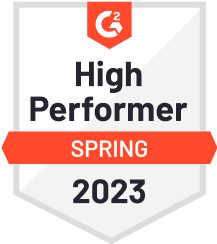
Real-time collaboration is synchronized teamwork where multiple people work together on the same task, file, document, or project at the same time, with updates and communication reflected instantly across all participants.
Removing delays between inputs increases productivity, accelerates decision-making, and keeps teams aligned on a single version of work. It also provides transparency that improves communication, strengthens engagement, and ensures higher-quality outcomes across projects.
Organizations use real-time collaboration for document creation, project management, client co-creation, training, and global teamwork, where speed and accuracy are essential. It is made possible through tools such as project management platforms, document co-editors, messaging and video conferencing apps, file-sharing systems, and digital whiteboards that bring people together in one workspace.
Despite its advantages, real-time collaboration comes with its own challenges, such as collaboration overload, distractions, time zone barriers, dependency on technology, and data security risks.
In this article, we discuss what real-time collaboration is, explore its benefits, explain how it works, and list the essential tools that enable it. We will also cover some common challenges, provide examples, and discuss best practices for implementing them.
What is real-time collaboration?
Real-time collaboration refers to the synchronized interaction or collaboration where multiple people contribute to the same task, file, document, or project at the same time, with updates and communication reflected instantly across all participants, regardless of their location.
It takes place in shared digital environments that integrate messaging, file editing, and task tracking into a single workspace. Every action is processed and displayed without delay, so teams see the same version of work as it develops, preventing version conflicts, reducing waiting time, and keeping all contributors aligned.
By combining simultaneous input with instant visibility, real-time collaboration enables faster progress and creates a continuous flow of teamwork that traditional, time-shifted methods cannot provide.
What are the benefits of real-time collaboration?
Real-time collaboration increases productivity, improves communication, saves time, enhances transparency, raises work quality, strengthens engagement, and enables faster decisions by keeping teams aligned in the same environment.
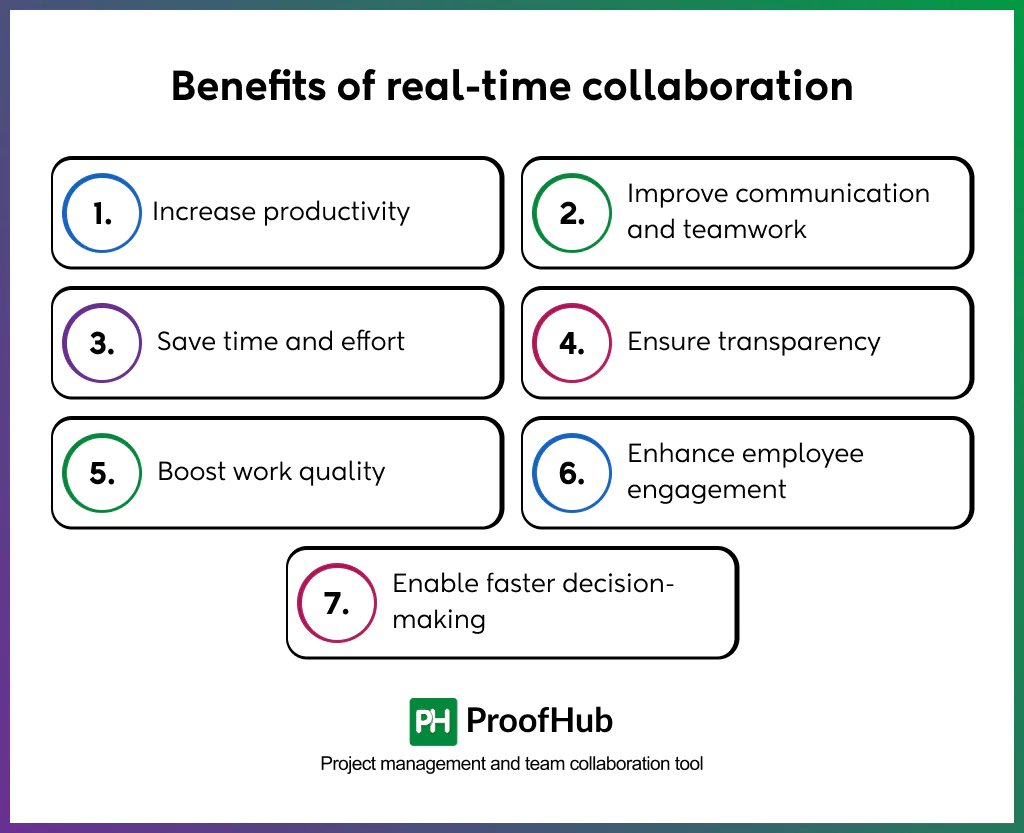
Here are some benefits of real-time collaboration:
1. Increase productivity: Working simultaneously reduces idle time and accelerates task completion. Teams avoid version conflicts and duplicated effort, ensuring steady progress, resulting in higher output without increasing resources or workload.
According to a study, “The Effect of Workload and Teamwork on Organizational Productivity,” conducted by Wahyu Abadi and Setyo Riyanto in 2021, teamwork has a direct, positive effect on organizational productivity by improving both the quality and volume of output without raising employee workload.
2. Improve communication and teamwork: Messages, edits, and feedback are exchanged instantly within the same workspace. This continuous flow of information keeps everyone aligned, reduces misinterpretations, and strengthens collaboration across departments and locations.
3. Save time and effort: Instead of waiting for responses or approvals, participants act immediately. A single shared version of documents or tasks eliminates rework, cutting down unnecessary steps and freeing time for higher-value activities.
4. Ensure transparency: Updates are visible to all team members as they happen. This visibility helps managers track progress, ensures accountability, and reduces the need for status meetings or repeated reporting.
5. Boost work quality: Instant feedback allows errors and problems to be solved quickly. Continuous input from multiple contributors improves accuracy and encourages refinement, resulting in deliverables that meet higher standards.
6. Enable faster decision-making: Decisions are made in the moment, with all information accessible to relevant stakeholders. This agility helps organizations respond to challenges or opportunities without losing momentum.
7. Enhance employee engagement: Active participation keeps employees involved throughout the process. Everyone can contribute ideas, see their impact immediately, and feel ownership of results, which strengthens motivation and satisfaction.
A study titled “Exploring the Relationship among Employee Participation and Job Satisfaction, Employee Commitment and Employee Performance” by Dr. Damas Dominic Suta in 2023 revealed that employee participation in decision-making increases job satisfaction and motivation by fulfilling self-actualization needs. It further showed that involving employees in shaping policies and goals improves performance by creating alignment and a stronger sense of ownership.
How does real-time collaboration work?
Real-time collaboration works by connecting team members in a shared digital environment where updates, edits, and communication are reflected instantly.
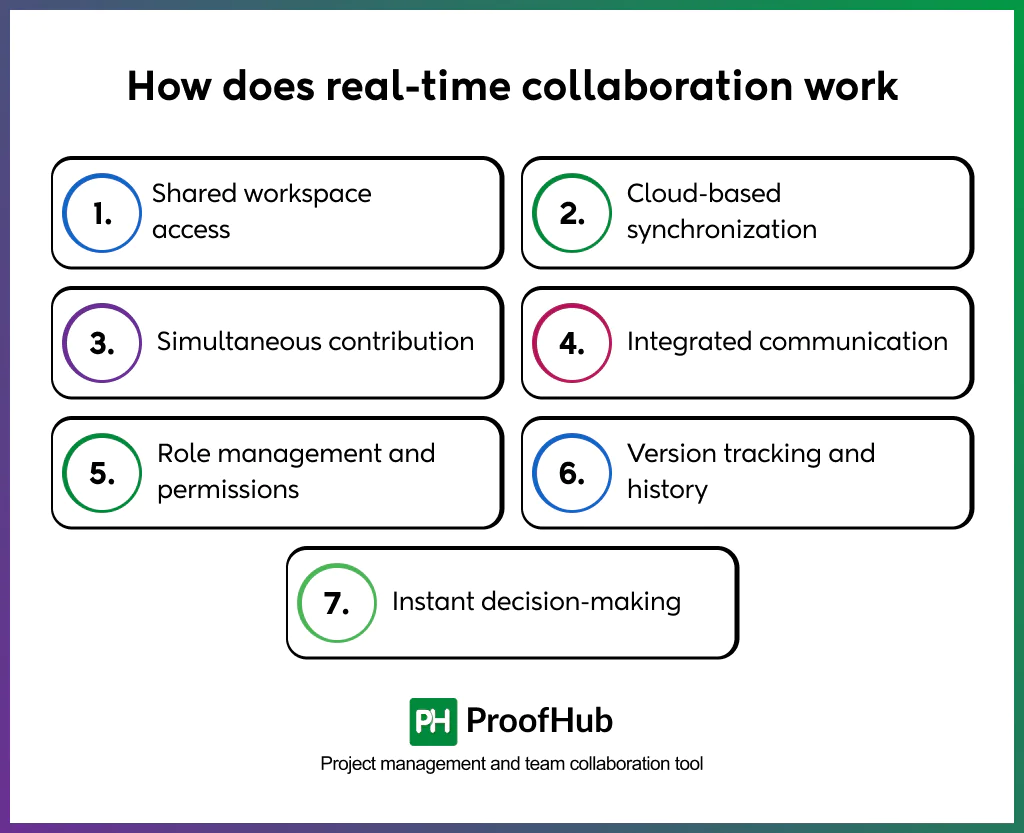
Here is how real-time collaboration works:
- Shared workspace access: All participants join a centralized platform (such as a project management tool, document editor, or virtual whiteboard). This ensures everyone works in the same environment, eliminating the need to switch between multiple file versions.
- Cloud-based synchronization: The platform relies on cloud technology to store data and instantly sync changes across devices. When one person makes an edit, it appears for everyone else immediately, maintaining consistency.
- Simultaneous contribution: Team members can type, draw, assign tasks, or update documents simultaneously. The system merges inputs automatically, so work continues smoothly without overwriting someone else’s progress.
- Integrated communication: Built-in chat, comments, tagging, and video conferencing allow quick discussions directly within the platform. This reduces the need for external emails and keeps context tied to the work itself.
- Role management and permissions: Teams assign roles (viewer, editor, admin) to control who can make changes or approve updates. This prevents confusion and safeguards sensitive information while still allowing collaboration.
- Version tracking and history: Every edit is logged in a version history, helping teams trace who made changes, restore earlier versions if needed, and maintain accountability across contributors.
- Instant decision-making: Because updates and discussions happen in real time, teams can review information together and finalize decisions swiftly, shortening approval cycles and keeping projects moving forward.
What are the uses of real-time collaboration?
The uses of real-time collaboration include client co-creation, document editing, project management, knowledge sharing, and cross-border teamwork.
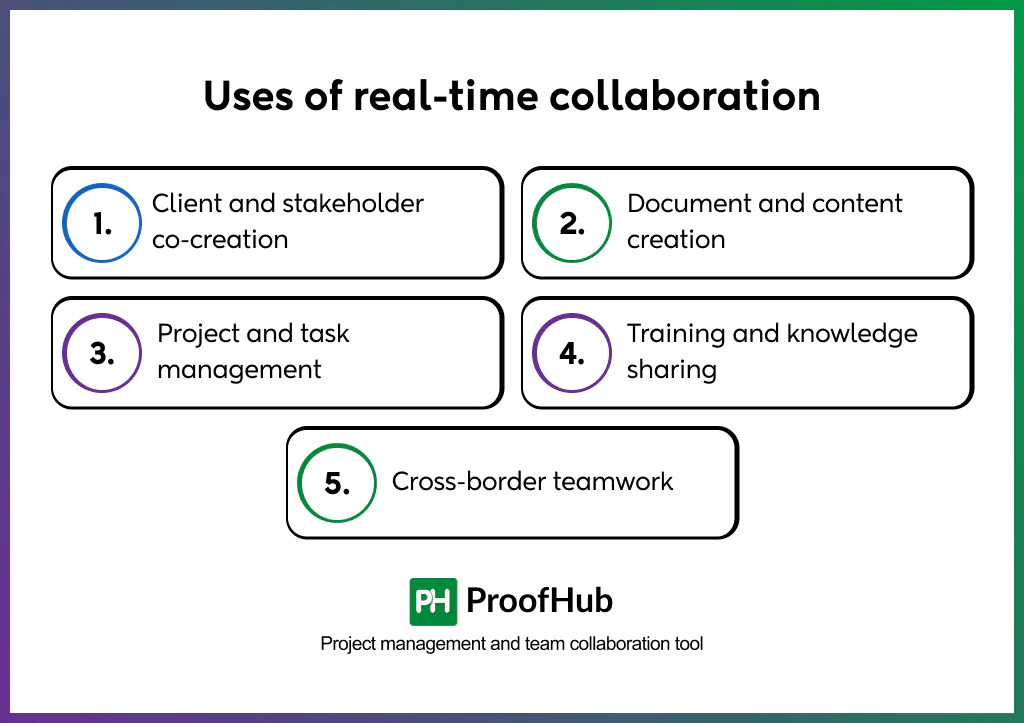
Here are some of the prominent uses of real-time collaboration:
- Client and stakeholder co-creation: Clients join shared workspaces to review drafts, designs, or proposals in real time. Feedback is integrated instantly, building trust and speeding up approvals. Beyond external collaboration, teams also use it internally to create content faster.
- Document and content creation: Multiple authors edit, review, and refine the same document simultaneously. This ensures a single version of truth, prevents duplication, and accelerates the delivery of reports, presentations, or contracts. From individual files, collaboration expands into larger workflows.
- Project and task management: Teams update task boards, assign responsibilities, and monitor progress in the moment. Managers see live status updates, reducing the need for check-ins. This direct project visibility connects naturally with communication during execution.
- Training and knowledge sharing: Workshops, onboarding, and live sessions use real-time platforms to connect trainers and participants. Interactivity creates engagement and ensures that knowledge is absorbed immediately.
- Cross-border teamwork: Distributed teams in different regions use real-time platforms to stay connected and work as if they were in the same room. This makes global collaboration seamless and prevents delays caused by geography. This sets the foundation for broader workplace uses.
What are the essential tools for real-time collaboration?
Real-time collaboration is enabled by digital tools such as messaging and chat platforms, video conferencing apps, project management platforms, document co-editors, file sharing, activity tracking, and digital whiteboarding solutions.
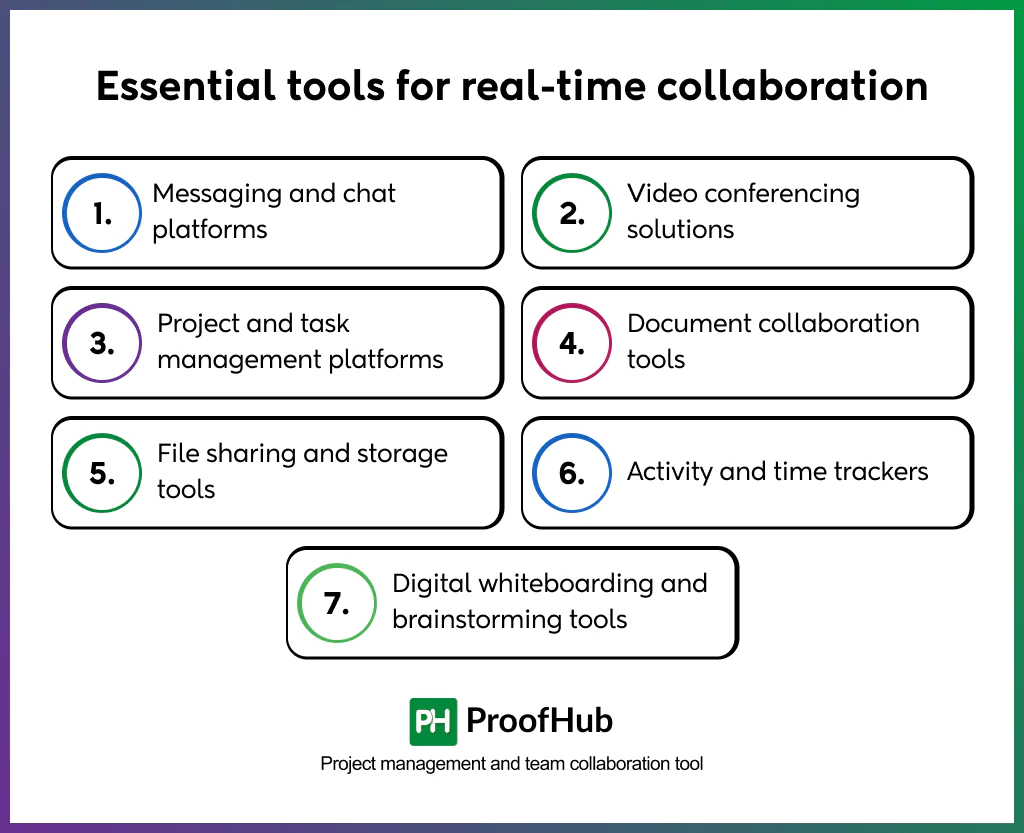
Here are some common real-time collaboration tools:
- Messaging and chat platforms
Instant messaging tools provide quick, informal communication that speeds up collaboration compared to email. Teams can create dedicated channels for projects, keep conversations organized, and get instant responses, reducing bottlenecks and delays.
- Video conferencing solutions
Video conferencing apps enable live discussions, brainstorming, and decision-making. They add context through facial expressions and tone of voice, making remote interactions more personal and engaging. These platforms are especially useful for team meetings, problem-solving sessions, and virtual workshops.
- Project and task management platforms
Project management tools provide a centralized workspace where teams can assign responsibilities, set deadlines, and monitor progress in real time. They give complete visibility into who is working on what, reduce duplicated efforts, and ensure projects stay aligned with timelines and goals.
- Document collaboration tools
Document collaboration tools allow multiple team members to create, edit, and review documents, spreadsheets, or presentations at the same time. Edits are reflected instantly, preventing version conflicts and eliminating the need for long email chains. Everyone sees the most recent changes, which speeds up approval cycles and knowledge sharing.
- File sharing and storage tools
Cloud-based file-sharing tools provide a central repository where documents, media, and resources can be stored and accessed securely. They prevent duplication, keep data organized, and make sure that team members always work with the latest version of a file.
- Activity and time trackers
Activity and time tracking tools monitor progress in real time and ensure accountability. They help managers balance workloads, optimize resources, and track time spent on projects, thereby improving efficiency and performance visibility.
- Digital whiteboarding and brainstorming tools
Digital whiteboards replicate in-person brainstorming sessions. Teams can map workflows, add sticky notes, and sketch ideas together, no matter where they are located. These tools encourage creativity and help visualize complex concepts in a shared space.
Some widely used real-time collaboration tools include:
- ProofHub: Combines project management, task tracking, and team collaboration in a single platform.
- Google Workspace: Offers real-time document, sheet, and presentation collaboration.
- Zoom: Reliable video conferencing for meetings, brainstorming, and workshops.
- Miro: A popular whiteboarding tool for visual collaboration.
- Dropbox: Centralized file storage and sharing with controlled access.
Best practices for implementing real-time collaboration
The best practices for implementing real-time collaboration involve choosing the right tools, defining clear processes, ensuring security, enabling easy onboarding, and promoting a culture of collaboration.
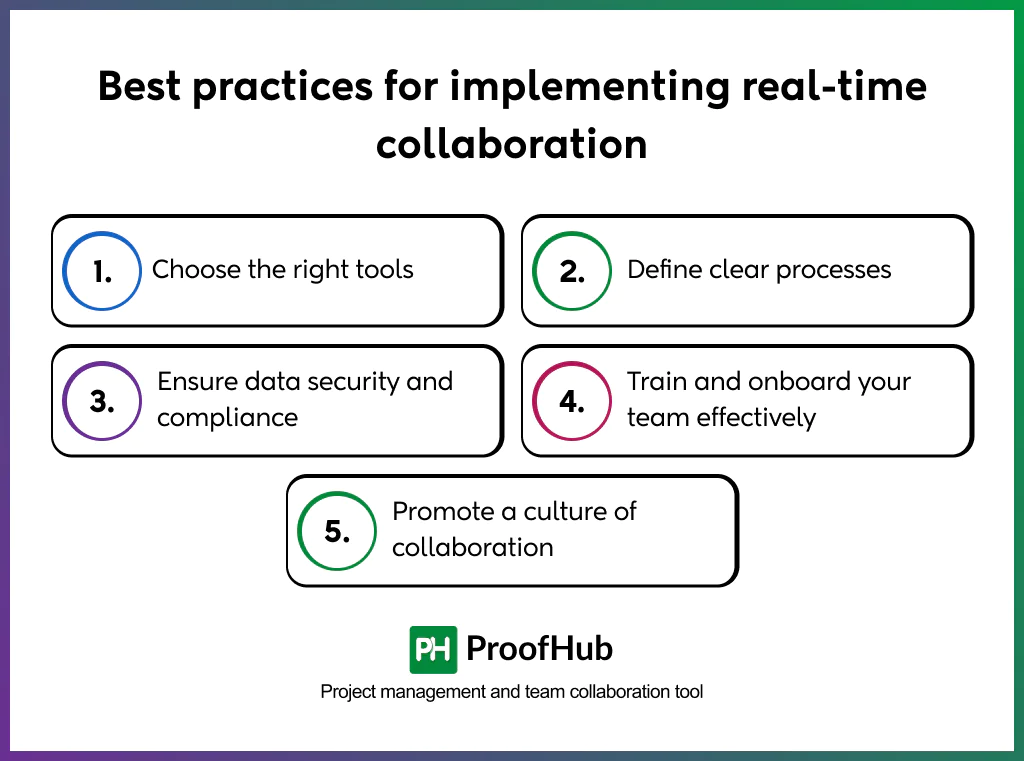
Here are some best practices to implement effective real-time collaboration.
- Choose the right tools: Select a tool that centralizes communication, tasks, and file sharing in one place. Avoid using fragmented tools, as they create silos and slow down collaboration. Look for features such as instant messaging, document co-editing, task management, and integrations with your existing systems.
- Define clear processes: Real-time collaboration can be a mess without structure. Establish rules for communication (which channel to use for what), set expectations for response times, and outline how approvals or decisions will be documented. Having clear workflows prevents miscommunication and keeps momentum steady.
- Ensure data security and compliance: When information is shared instantly, risks multiply. Secure your environment by defining permissions, enabling multi-factor authentication, encrypting data, and using audit trails to track changes. This protects sensitive information as well as ensures compliance with industry regulations.
- Train and onboard your team effectively: Tools alone don’t guarantee collaboration. Provide training so employees understand how to use platforms for messaging, file-sharing, and task updates. Use onboarding guides, role-based training, and practical workshops so adoption becomes seamless rather than overwhelming.
- Promote a culture of collaboration: Even the best tools fail if employees don’t use them. Encourage open communication, recognize collaborative efforts, and promote transparency. Build trust, encourage idea-sharing, and celebrate team wins for creating a culture of real-time collaboration.
What are the challenges of real-time collaboration?
The challenges of real-time collaboration include communication overload, distractions, unequal participation, dependency on technology, security risks, time zone differences, and lack of documentation.
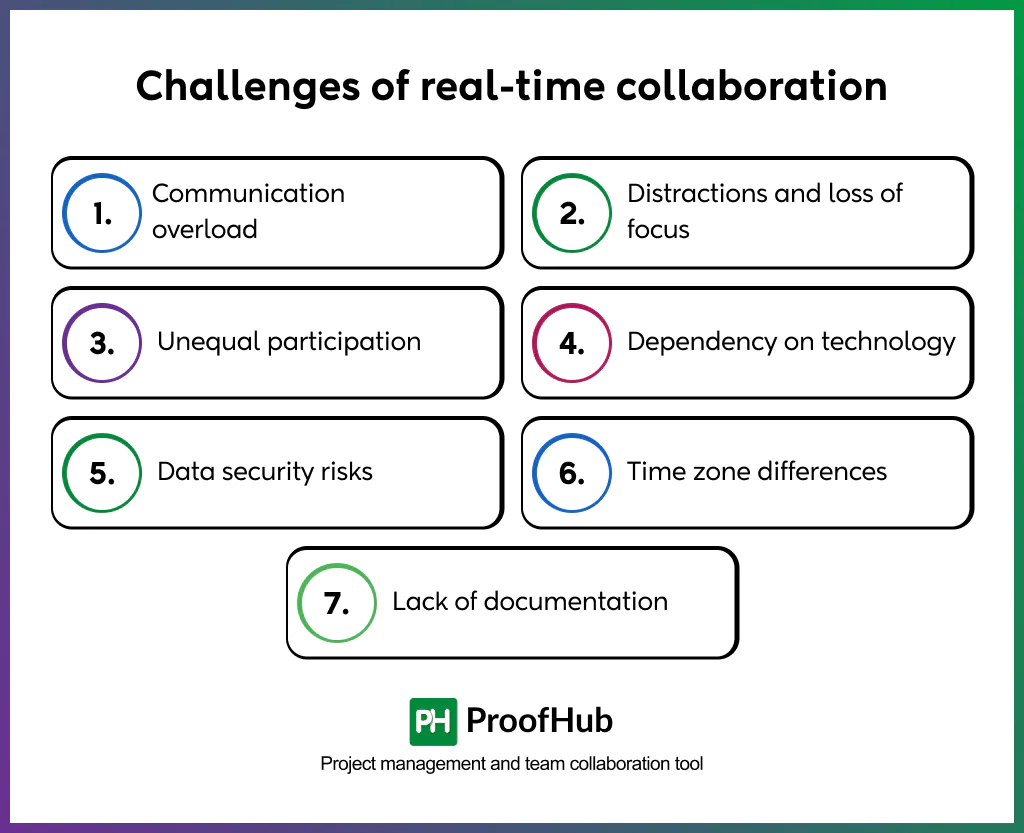
Here are the most common challenges of real-time collaboration and how to address them effectively:
1. Communication overload: Constant messages, alerts, and live discussions can overwhelm teams, leading to decision fatigue and reduced focus on meaningful work.
To overcome this challenge, define clear communication protocols, set boundaries on notifications, and use focused discussion channels for specific topics. Encourage teams to summarize discussions into actionable items.
2. Distractions and loss of focus: Frequent interruptions in live collaboration can disrupt deep work, reducing productivity and quality of output.
Establish “focus hours” where real-time collaboration is paused, and use collaboration tools that allow toggling between synchronous and asynchronous modes.
3. Unequal participation: In group discussions, some voices may dominate while others stay silent, resulting in skewed decisions and a lack of inclusivity.
Use structured collaboration formats, such as round-robin check-ins, assign facilitators, and leverage tools with features like hand-raise or anonymous input collection.
4. Dependency on technology: Real-time collaboration heavily depends on stable internet connections and reliable tools. Any downtime can stall progress.
A study titled “The Effects of Network Outages on User Experience in Augmented Reality Based Remote Collaboration – An Empirical Study” conducted by Tooba Ahsen, Zi Yi Lim, Aaron L. Gardony, Holly A. Taylor, Jan P. De Ruiter, and Fahad Dogar in 2021 revealed that network outages significantly disrupt user experience and reduce collaboration effectiveness, reinforcing the need for stable connectivity and reliable platforms to maintain workflow continuity.
Choose robust, secure platforms with offline access or fallback modes, and have contingency plans in case of outages.
5. Data security risks: Sensitive information exchanged through instant communication platforms may expose organizations to leaks, breaches, or compliance violations.
To address this, use encrypted platforms, set strict access permissions, and adopt centralized storage with audit trails and compliance controls.
6. Time zone differences: Distributed teams struggle to collaborate in real time when schedules don’t overlap, causing delays and frustration.
Rotate meeting times to share the burden, use overlapping “golden hours” for live discussions, and rely on asynchronous tools when real-time isn’t practical.
7. Lack of documentation: Since discussions occur instantly, critical decisions and context may not be adequately recorded, leading to confusion later.
Assign note-takers or use tools that auto-generate transcripts and summaries. Store meeting notes and updates in a centralized workspace for future reference.
What are the examples of real-time collaboration?
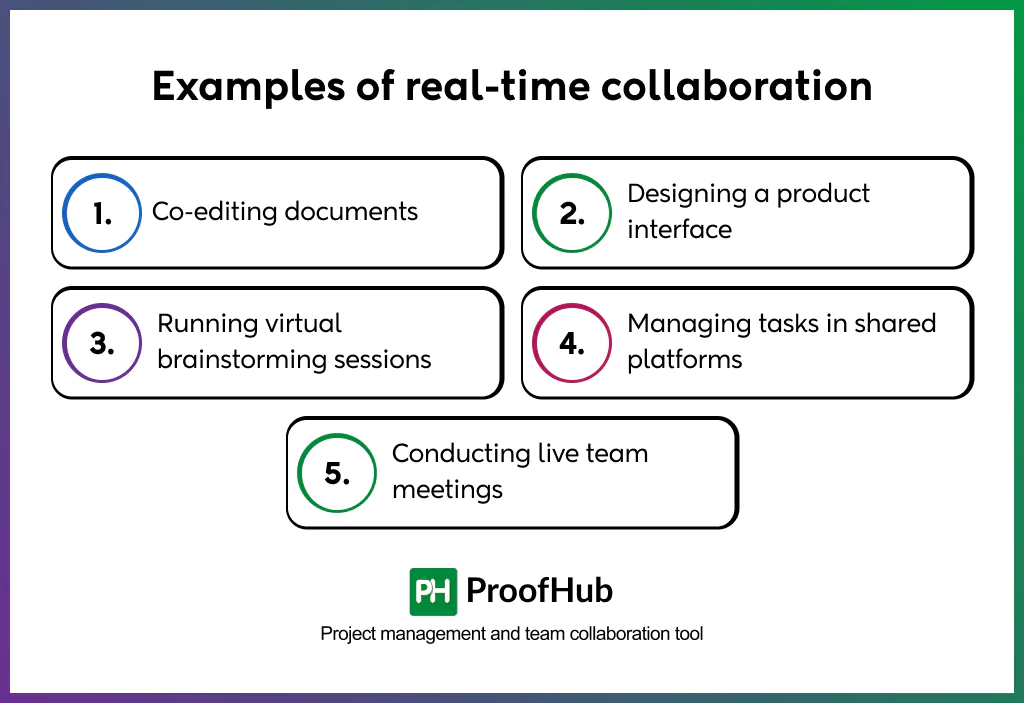
Some of the examples of real-time collaboration include:
1. Co-editing documents: A marketing team drafts a campaign plan in Google Docs. While one member writes copy, another updates budget tables, and a manager reviews sections simultaneously. This eliminates version conflicts and speeds up approvals.
2. Designing a product interface: A product design team uses Figma to create a new app interface. The UX designer adjusts layouts while another team member adds visuals, and a project manager provides feedback in real time. This synchronized workflow reduces revision cycles and ensures design consistency.
3. Running virtual brainstorming sessions: A distributed innovation team uses Miro to brainstorm product ideas. Participants add sticky notes, cluster themes, and vote on priorities in real time, replicating the dynamics of a physical whiteboard session.
4. Managing tasks in shared platforms: A software development team works in ProofHub. Developers update task progress, testers log issues, and managers adjust deadlines instantly. This visibility keeps the sprint aligned and prevents blockers.
5. Conducting live team meetings: An HR department hosts an onboarding session on Zoom. Trainers present materials while new hires ask questions through chat, and breakout rooms allow role-based discussions, all happening live to ensure clarity and engagement.
When is real-time collaboration mainly used?
Real-time collaboration is mainly used when tasks need instant input, alignment, or immediate decision-making.
Some of the situations in which real-time collaboration is used are:
- Project planning and execution: Teams co-develop plans, assign tasks, and track progress simultaneously.
- Creative work: Designers, writers, and marketers refine assets together in live editing sessions.
- Crisis response and problem-solving: Organizations act quickly on issues that demand immediate solutions.
- Cross-functional teamwork: Different departments coordinate in real time to avoid silos and delays.
- Remote and hybrid work: Distributed teams collaborate as if they were in the same room, reducing gaps caused by distance.
The common factor is time sensitivity; when waiting would slow progress, real-time collaboration ensures continuity and speed.
What is the difference between real-time and asynchronous collaboration?
The main difference between real-time and asynchronous collaboration lies in when participants contribute and how interaction is managed.
Real-time collaboration happens simultaneously. Team members work together at the same time in a shared digital environment where updates, edits, and communication appear instantly. It is used in activities such as brainstorming sessions, client meetings, or co-editing documents where speed and alignment are critical.
Asynchronous collaboration happens at different times. Individuals contribute independently, and responses are delayed until others review and act. It is used in situations like writing documentation, managing task boards, or sharing recorded updates where flexibility is more valuable than immediacy.
How to avoid distractions during real-time collaboration?
You can avoid distractions during real-time collaboration by setting clear rules, structuring communication, and using tools effectively. Begin each session with a defined purpose or agenda to prevent unnecessary discussions. Limit notifications and mute unrelated channels to maintain focus on the shared task.
Distractions are also reduced when only the necessary participants are involved, ensuring conversations stay relevant—set time blocks to keep sessions short and purposeful, avoiding fatigue and interruptions. Use tool features such as focus mode, do-not-disturb settings, or document locking to minimize parallel edits that may otherwise break concentration.
Can real-time collaboration affect deep work?
Yes, real-time collaboration affects deep work because constant interaction and instant communication can interrupt long, focused periods of concentration.
Deep work requires uninterrupted time for problem-solving, analysis, or creative thinking, while real-time collaboration emphasizes immediacy and rapid response. Frequent notifications, live edits, or ongoing discussions may fragment attention and reduce the quality of individual output.
To balance both, organizations can allocate separate blocks for deep work and use real-time collaboration selectively for activities where instant alignment is essential.




